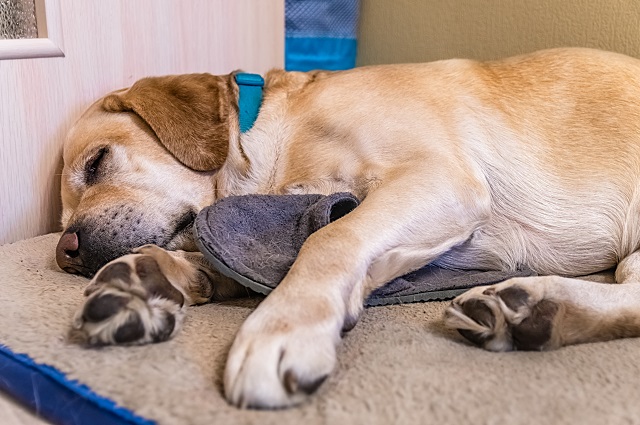Blood Coming From My Labrador Retriever’s Anus: If your Labrador Retriever is bleeding from their anus, you, like any pet owner, would be concerned. Bleeding from the rectum can be a serious symptom.
It is possible for this to happen for several reasons. These include a problem with the Anal glands, foreign bodies being eaten, rat poisoning, hemorrhaging, and constipation.
Anal Gland Problems Can Cause Bleeding In Labrador’s
Anal gland problems are the most common cause of rectal bleeding. Your lab’s anus contains two scent glands. When faecal matter passes through these glands, it emits a small amount of odour.
It creates a distinct smell that tells other dogs who the poo comes from. Anal glands can also release smells from the dog in response to fear and anger – if you have ever smelled anal gland liquid, you know that it is similar to the smell of rotten fish.
How Does Anal Abscess Develop?
It is possible for your Labrador’s anal glands to become impaired by obstruction of the duct from the glands to the anus. The most common causes of obstruction in the duct are soft stool or diarrhea, infections that cause inflammation of the sac and duct.
There is a common misconception that your Lab scoots implies it has worms. It is interesting to note that worms and parasites do not contribute to anal inflammation.
Anal glands are usually not enlarged and not painful at this point in a Labrador Retriever’s life. In this case, your Labs rectum can become painful, swollen, and often develop into an abscess when an anal gland infection occurs.
The anal gland may also bleed. The infection occurs when the obstruction of the duct causes localized inflammation.
Symptoms of Anal Gland Issues
Anal gland problems can then appear in your Lab at any time, with the most common one being:
| Excessive licking of the anal area and hind end | Bleeding and/or swelling near the anal region |
| Releasing a sudden foul (fishy) odour | Straining to defecate |
| Scooting and discomfort of the rear end | Leaking of anal gland fluid |
How Is Anal Gland Issues Treated?
Unless you feel comfortable doing this at home, you may not be up to the challenge. If you are doing this for the very first time, you should have a veterinarian show you how.
While you perform the procedure, you should have a second person nearby to help your Lab hold still.
If you express poorly, you may create irritation and cause further issues, so make sure you can complete your tasks in the most effective way possible.
Labrador Retriever anal sacs may need to be expressed frequently if your dog’s scooting in the house is chronic. You may elect to have the anal sacs surgically removed.
Can Foreign Body Ingestion Cause Bleeding In Labrador’s
When your Labrador Retriever eats something, it will take 10-24 hours for the food to pass through their digestive system. Certain foods, however, could take longer. There are sometimes items that are just too large to pass through the digestive system, and if this is the case, obstructions will occur.
Generally, foreign objects that reach the colon will pass – but there is still the possibility that they may be uncomfortable – particularly if they are sharp. Veterinarian assistance is recommended in such circumstances. Don’t pull any foreign material out of your lab’s rectum. The internal tissues of your Lab can be damaged if it is still inside your Lab.
Symptoms If The Object Becomes Stuck
Consider these common signs to determine whether you should seek veterinary care:
| Vomiting | Bleeding from the rectum |
| Abdominal tenderness or pain | Diarrhea |
| Straining to defecate | Lack of appetite |
| Lethargy | Behavioural changes such as biting or growling |
In the case of suspected blockage caused by an object, your vet will perform x-rays to confirm the condition. For the identification of an object, multiple x-rays utilizing contrast dyes (dyes) will be required.
As part of your veterinarian’s assessment of the effect the obstruction has had on your Lab’s general health, blood tests may also be recommended.
During the test, they will also look for other possible causes, such as enteritis, pancreatitis, parasites, or hormonal disorders, such as Addison’s disease.

Treatment of Foreign Body Ingestion
There are a few treatment options depending on the health of your Labrador Retriever if he eats an object like a stick, a rock, or another strange object.
When your lab has been vomiting too much, crying in pain, and basically being distressed. A vet will be able to treat you with intravenous fluids and pain medication right away.
In case your Labrador Retriever still has a foreign object in their stomach you might be able to make them vomit in order to get rid of it.
It is also possible to extract the item through endoscopy, which involves inserting a long tube into your Lab’s mouth and using it to remove it from their stomach.
Veterinarians will make suggestions and, if necessary, will ask for your Labrador Retriever to be hospitalized in order to receive close supervision.
It is inevitable that an operation will be necessary if the object enters the intestinal tract. An obstruction in the intestine or abdomen, as described earlier, will prevent blood from flowing to the stomach and digestive tissues. The tissue may become necrotic within a few hours.
Can Rat Poisoning Cause Bleeding In Labradors?
Basically, there are two types of rat poison: first-generation baits, such as Ratblitz, which has a brief effect, but needs to be ingested for a long time before it is deadly. Talon and Ratsak, second-generation baits, which have an extended rapid onset and are deadly at a single dose.
Rat poison reduces the body’s natural supply of vitamin K, which is critical for coagulation. Vitamin K is a fat-soluble vitamin that plays an essential role in blood coagulation. After absorption, the first signs of poisoning may not appear for up to five days.
Symptoms Of Rat Poisoning
Poisoning is commonly associated with bleeding, which may range from quite mild symptoms, like minor bleeding of the gums, to significant bleeding from anywhere.
In the presence of a functioning clotting system, these injuries are automatically fixed without even being conscious of them.
However, if the clotting system is not functioning, then these small injuries will continue to bleed, which will result in symptoms such as:
| Lethargy | Blood in the urine or faeces |
| Bruising under the skin | Bleeding from the nose and Anus |
| Continued bleeding from small cuts | Vomiting and diarrhoea |
| Seizures and muscle tremors | Coughing or breathing difficulties |
| Lameness | Pale gums |
Rat Poisoning Treatment In Dogs
It’s very imperative to get your Labrador examined by a veterinarian right away if you see them eating rat poison. When you notice symptoms that may indicate that your Lab was poisoned, even if you haven’t seen it consume any rat poison, then you should see your vet as soon as possible.
Blood tests will be needed to determine whether clot formation is occurring and whether iron deficiency is present. If you have a Labrador Retriever with this condition, the treatment could be as simple as offering vitamin K supplements for up to six weeks, or it could involve more intensive treatment, such as blood transfusions and hospitalization.
Occasionally, even the most intensive care may not be enough to save all dogs.
Hemorrhage Causing Anal Bleeding In Labradors
A dog suffering from hemorrhagic gastroenteritis experiences sudden vomiting and diarrhea containing varying amounts of blood. It most frequently affects small dogs and medium-sized dogs.
During this time, your Labrador may look slightly sick, but it is also possible for them to appear fully normal before symptoms erupt. However, the disease is rapidly progressing, and it is imperative that it is treated accordingly.
Haemorrhagic gastroenteritis is not well understood. However, bacteriological toxicity may be at fault. Eating spoiled foods can exacerbate the symptoms.
The intestinal system is rapidly and severely dehydrated due to rapid and severe blood and fluid loss from the bloodstream.
As a consequence, the blood can become so thick that it moves through the blood vessels very slowly. The effects of haemorrhagic gastroenteritis are fatal if left untreated.
Symptoms of Hemorrhage
Blood in the stool is a characteristic of dogs suffering from haemorrhagic gastroenteritis. Your Lab may have haemorrhagic gastroenteritis if these signs are present:
| Stool with mixed mucous and blood |
| Drops of blood from the rectum |
| Clumps or pools of the gelatinous bloody fluid |
Treatment of Hemorrhage
Due to the uncertainty of a Lab’s condition, veterinary treatment is recommended in all cases of diarrhoea, particularly with puppies and old dogs who are more at risk of dehydration.
Symptoms such as vomiting, nausea, pain, or fatigue must be treated by a veterinarian.

